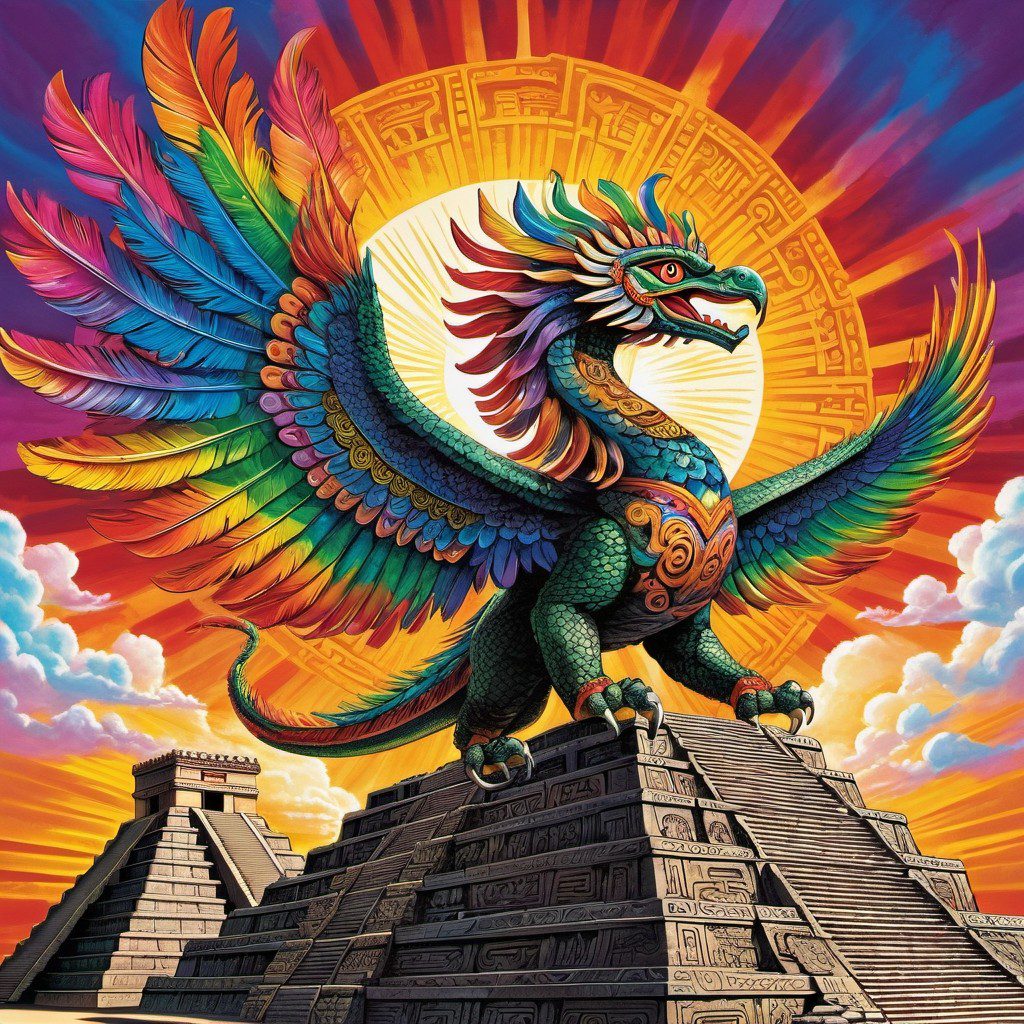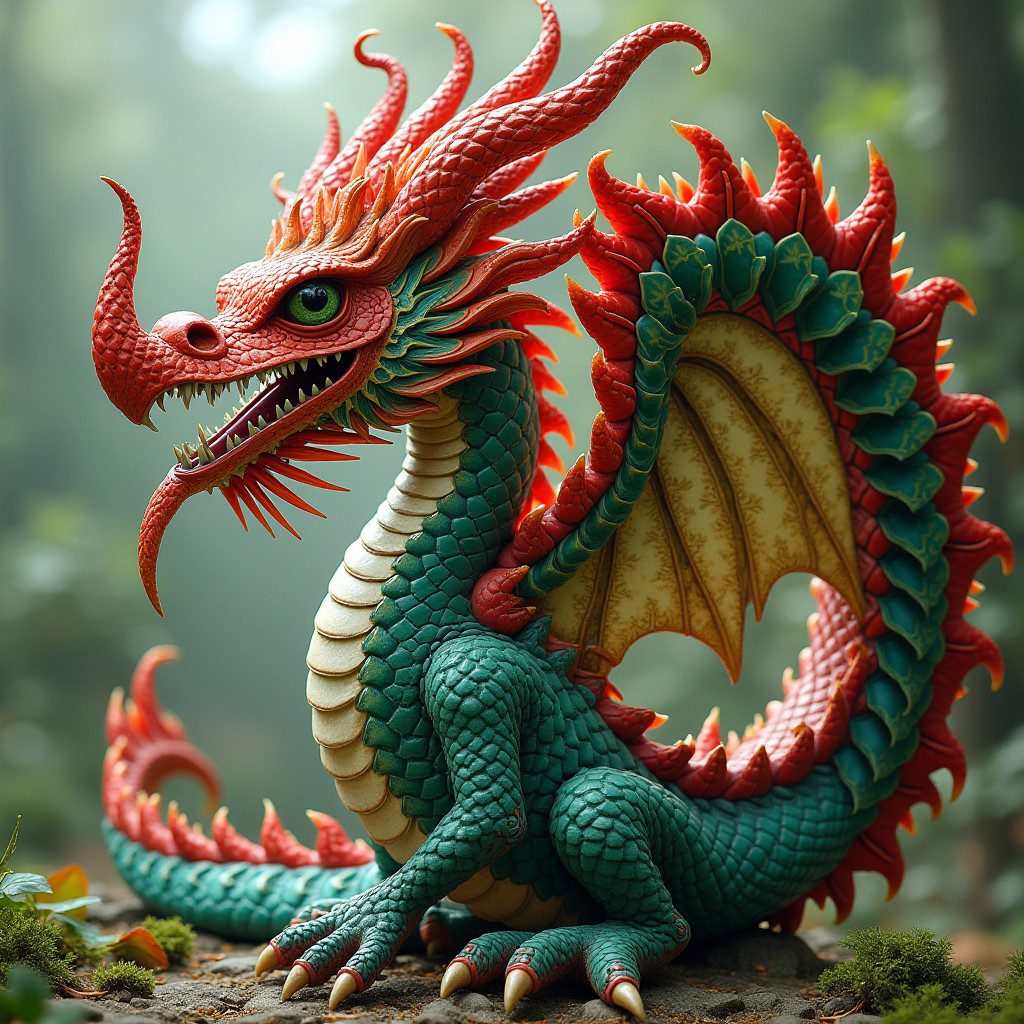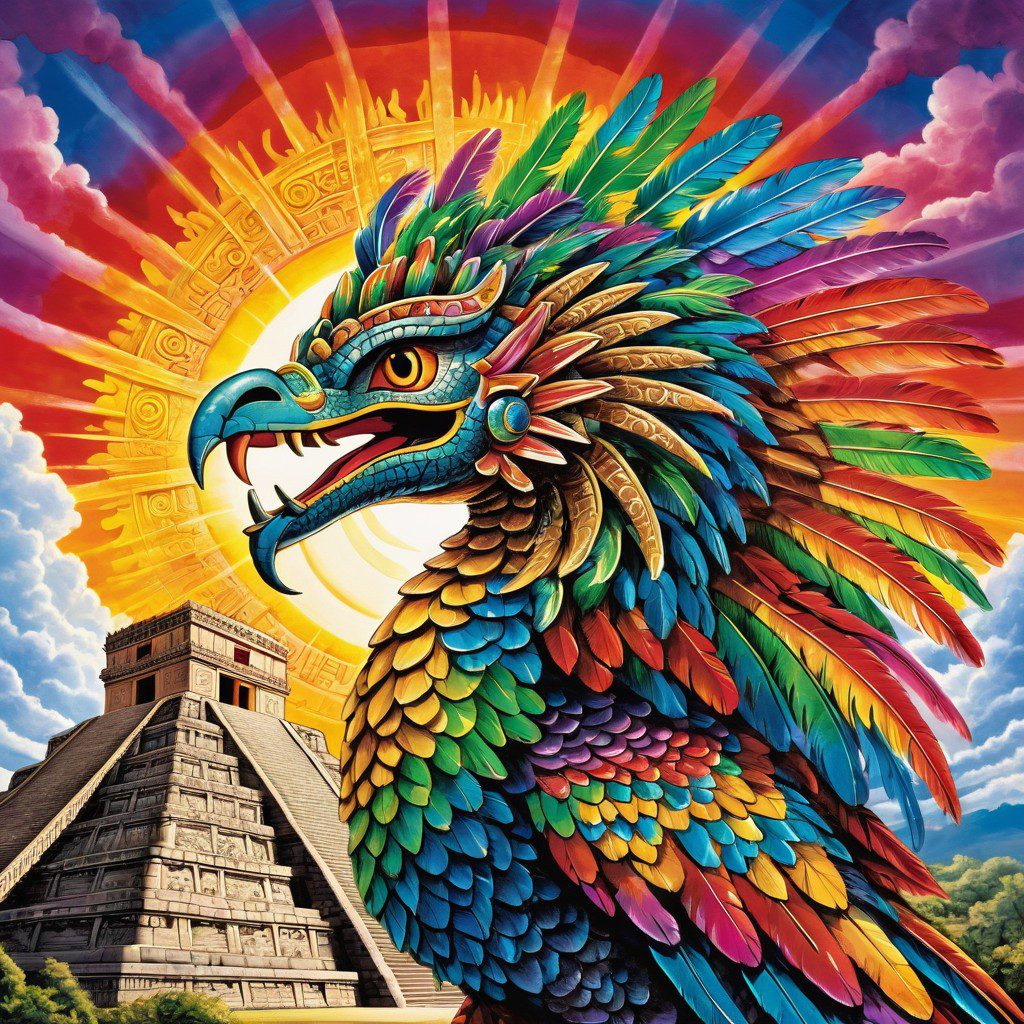Quetzalcoatl: The Feathered Serpent God of Mesoamerican Mythology

Among the vast pantheon of Mesoamerican deities, Quetzalcoatl stands out as one of the most important and complex gods in ancient mythology. Revered as the feathered serpent, Quetzalcoatl embodied a unique combination of elements: he was a creator, a god of knowledge, wind, and life, and in some traditions, a deity associated with death and resurrection. As both a bringer of civilization and a symbol of fertility and regeneration, Quetzalcoatl played a pivotal role in the religious and cultural practices of ancient civilizations such as the Aztec, Toltec, and Maya.
Though his influence in the ancient world spanned centuries, Quetzalcoatl’s legacy continues to resonate in modern culture, where he remains a symbol of wisdom, power, and the interconnectedness of life and death.
The Origins of Quetzalcoatl
The name Quetzalcoatl is derived from the Nahuatl language, meaning “feathered serpent” (quetzal = bird/feathers, coatl = serpent). This duality reflects his role as a deity who connected the sky and the earth, the spiritual and the material worlds.
Quetzalcoatl’s worship began among the Olmecs, one of the earliest Mesoamerican civilizations (circa 1200–400 BCE), and he later became a major figure in the religions of the Toltecs and Aztecs. He was often associated with the wind, the morning star (Venus), knowledge, and the priesthood, embodying both intellectual and creative aspects of life. In some myths, Quetzalcoatl was even credited with creating humanity and giving them the tools of civilization, such as agriculture, art, and culture.
The figure of Quetzalcoatl took on different aspects depending on the time and culture, but his essential nature as a beneficent god who brought knowledge and prosperity remained central across various Mesoamerican societies.
Quetzalcoatl as a Creator God
In Aztec cosmology, Quetzalcoatl was one of the four gods who played a role in creating the world. According to legend, Quetzalcoatl and his brother Tezcatlipoca (the god of darkness and sorcery) worked together to create the earth from the remains of a primordial monster. Despite this collaboration, the two gods are often depicted as rivals, representing opposing forces: Quetzalcoatl as a benevolent and life-giving deity, and Tezcatlipoca as a god of chaos and destruction.

One of Quetzalcoatl’s most significant contributions in Aztec mythology is his role in the creation of humans. In one myth, Quetzalcoatl descended into the underworld to retrieve the bones of past generations of humans. He ground these bones into a fine powder, mixed them with his own blood, and from this mixture, the first humans of the current age were born. This act not only positioned Quetzalcoatl as the creator of humanity but also highlighted his role as a god of sacrifice and rebirth.
The Feathered Serpent: Symbolism and Iconography
Quetzalcoatl’s image as a feathered serpent is one of the most striking and enduring symbols in Mesoamerican art and mythology. This combination of bird and snake elements is symbolic of the duality of his nature: the serpent represents the earth and physicality, while the feathers represent the sky, wind, and the spiritual realm. Together, they signify Quetzalcoatl’s ability to move between different planes of existence, serving as a bridge between the human world and the divine.
In Aztec temples and monuments, Quetzalcoatl is often depicted as a large snake adorned with colorful quetzal feathers, sometimes with a human face emerging from the serpent’s jaws. This blending of human, animal, and divine traits further reinforces his role as a multifaceted deity who oversees many aspects of life, including knowledge, culture, and fertility.
In addition to his serpentine form, Quetzalcoatl was also associated with wind and the morning star (Venus). As the god of wind, he was called Ehécatl, and he was believed to sweep away the darkness of the night and bring the dawn. His association with Venus linked him to cycles of renewal and resurrection, reinforcing his connection to life, death, and rebirth.
Quetzalcoatl and the Arrival of the Spanish
Quetzalcoatl is perhaps most famously associated with the legend surrounding the Spanish conquest of the Aztec Empire in the early 16th century. According to some versions of the story, the Aztec emperor Moctezuma II believed that the Spanish conquistador Hernán Cortés might be the returning Quetzalcoatl, fulfilling a prophecy that the god would come back to reclaim his throne.
This belief was rooted in ancient myths that said Quetzalcoatl had once ruled as a king-priest in the city of Tollan, but was tricked by Tezcatlipoca into becoming drunk and disgracing himself. Quetzalcoatl fled eastward, vowing to return one day to reclaim his throne. When Cortés arrived on the shores of Mexico in 1519, Moctezuma, seeing the pale-skinned Spaniards arriving from the east, reportedly believed Cortés was the returning god. This misconception has been cited as one of the reasons why the Aztecs were initially hesitant to resist the Spanish invasion.
However, modern historians and scholars debate the accuracy of this narrative, suggesting that it may have been exaggerated or misconstrued by later accounts. Nonetheless, the association between Quetzalcoatl and the conquest of Mexico remains one of the most enduring and dramatic elements of his myth.
Quetzalcoatl in Modern Media and Culture
The image of Quetzalcoatl as the feathered serpent continues to inspire modern art, literature, and pop culture. His dual nature and his role as a bringer of civilization have made him a prominent figure in representations of Mesoamerican culture.

In video games such as Final Fantasy and Civilization, Quetzalcoatl appears as a powerful god or summon, often associated with lightning, wind, or knowledge. His unique combination of divine wisdom and serpentine power make him an intriguing figure for players to interact with or worship.
In literature, Quetzalcoatl is frequently portrayed as a tragic figure, a god who sought to bring humanity enlightenment and civilization, only to be misunderstood or betrayed. His story has been adapted and reimagined in novels, graphic novels, and television series that explore themes of power, sacrifice, and renewal.
The feathered serpent also serves as a prominent symbol in Mexican national identity. The serpent and eagle, representing the fusion of indigenous and colonial cultures, are central figures in the Mexican flag. Quetzalcoatl’s imagery and legacy can also be found in modern Mexican art, murals, and festivals, where he is celebrated as both a cultural hero and a spiritual figure.
Strengths and Weaknesses of Quetzalcoatl
Strengths:
- Creator of Humanity: Quetzalcoatl is revered as the god who created humans from the bones of previous generations, cementing his role as a life-giver and protector of civilization.
- Wisdom and Knowledge: As the god of learning, Quetzalcoatl is associated with wisdom, culture, art, and the sciences. He brought important aspects of civilization to humanity, including agriculture and writing.
- Power over Wind and Air: As the god of wind (Ehécatl), Quetzalcoatl had control over the elements, using his breath to disperse darkness and bring the morning light, symbolizing renewal and the cycle of life.
Weaknesses:
- Tricked by Tezcatlipoca: In many myths, Quetzalcoatl is deceived by his brother, Tezcatlipoca, who causes him to fall into disgrace. This act of trickery shows that even gods of great power can be vulnerable to manipulation.
- Voluntary Exile: After his fall from grace, Quetzalcoatl voluntarily leaves the city of Tollan and retreats, showing that his sense of honor and responsibility may also lead to self-imposed exile.
- Misinterpreted by Humans: In the context of the Spanish conquest, the belief that Cortés was Quetzalcoatl returning highlights how human misunderstanding of divine will can have disastrous consequences.
Quetzalcoatl: The Feathered Serpent and Bringer of Civilization
Quetzalcoatl remains one of the most enduring and complex gods in Mesoamerican mythology. As the feathered serpent, he represents the duality of nature: the earth and the sky, knowledge and creation, life and death. His legacy as a creator god, protector of humanity, and symbol of rebirth continues to influence modern depictions of Mesoamerican culture, serving as a reminder of the deep spiritual connections between humanity, the natural world, and the divine.
From the myths of ancient Mexico to his place in modern media, Quetzalcoatl’s influence transcends time, offering wisdom and hope for regeneration in both the material and spiritual realms.
